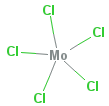|
MOLYBDENUM CHLORIDE |
| Synonyms. Molybdenum chloride; Molybdenum pentachloride; Molybdenum(V) chloride; Pentachloromolybdenum; Molybdenum(V) chloride; Pentachloridomolybdenum; |
| PRODUCT IDENTIFICATION | |
|
CAS RN |
10241-05-1 |
|
EINECS RN |
233-575-3 |
|
FORMULA |
MoCl5 |
|
MOLE WEIGHT |
273.21 |
|
H.S CODE |
2827.39.9000 |
|
SMILES |
Cl[Mo](Cl)(Cl)(Cl)Cl |
|
CLASSIFICATION |
|
|
EXTRA NOTES |
|
|
|
| PHYSICAL AND CHEMICAL PROPERTIES | |
|
PHYSICAL STATE. |
dark green to black crystalline powder |
|
MELTING POINT |
194 C |
|
BOILING POINT |
268 C |
|
DENSITY |
2.928 |
|
SOLUBILITY IN WATER |
Reacts |
| SOLVENT SOLUBILITY |
Soluble in dry ether, dry alcohol, organic solvents |
|
VAPOR DENSITY |
|
|
log P(octanol-water) |
|
|
VAPOR PRESSURE |
|
|
AUTOIGNITION TEMP |
|
| pK |
|
|
REFRACTIVE INDEX |
|
|
FLASH POINT |
|
|
|
| STABILITY AND REACTIVITY | |
| STABILITY | Stable under normal conditions. |
|
INCOMPATIBLE MATERIALS |
Strong oxidizing agents, Moisture. |
| POLYMERIZATION |
Has not been reported |
|
NFPA RATINGS |
Health: 3, Flammability: 0, Reactivity: 0 |
|
|
| EXTERNAL LINKS & GENERAL DESCRIPTION |
|
USA.gov - Molybdenum chloride Wikipedia Linking - Molybdenum chloride Google Scholar Search - Molybdenum chloride U.S. National Library of Medicine - Molybdenum chloride PubChem Compound Summary - Molybdenum chloride ChEBI (http://www.ebi.ac.uk/chebi/) - Molybdenum chloride NCBI (http://www.ncbi.nlm.nih.gov/) - Molybdenum chloride Material Safety Data Sheet - Molybdenum chloride EPA - Substance Registry Services - Molybdenum chloride |
|
|
| SALES SPECIFICATION | |
|
APPEARANCE |
dark green to black crystalline powder |
|
ASSAY |
95% min |
|
LOSS ON DRYING |
1.0% max |
|
|
| TRANSPORT & REGULATORY INFORMATION | |
|
UN NO. |
2508 |
| HAZARD CLASS |
8 |
| PACKING GROUP | III |
|
|
| SAFETY INFORMATION | |
|
HAZARD OVERVIEW |
GHS (Globally Harmonised System) Classification: Acute toxicity (Oral). Skin irritation. Eye irritation. Specific target organ toxicity - single exposure. Hazard statements: Causes skin irritation. Causes serious eye irritation. May cause respiratory irritation. |
| SIGNAL WORD | Danger |
|
PICTOGRAMS |
|
|
HAZARD STATEMENTS |
H314 Causes severe skin burns and eye damage. |
|
PRECAUTIONARY STATEMENTS |
P201 Obtain special instructions before use. |
| EC DIRECTIVES |
|
| HAZARD CODES |
|
|
RISK PHRASES |
14 Reacts violently with water. |
|
SAFETY PHRASES |
8 Keep container dry. |
|
|
| PACKING |
|
Preserve in light-resistant and well-closed containers |
|
|
| PRICE INFORMATION |
|
|


